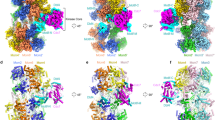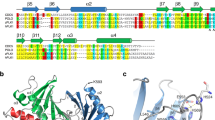Abstract
CDC7 is a serine/threonine kinase that is essential for the initiation of eukaryotic DNA replication. CDC7 activity is controlled by its activator, DBF4. Here we present crystal structures of human CDC7–DBF4 in complex with a nucleotide or ATP-competing small molecules, revealing the active and inhibited forms of the kinase, respectively. DBF4 wraps around CDC7, burying approximately 6,000 Å2 of hydrophobic molecular surface in a bipartite interface. The effector domain of DBF4, containing conserved motif C, is essential and sufficient to support CDC7 kinase activity by binding to the kinase N-terminal lobe and stabilizing its canonical αC helix. DBF4 motif M latches onto the C-terminal lobe of the kinase, acting as a tethering domain. Our results elucidate the structural basis for binding to and activation of CDC7 by DBF4 and provide a framework for the design of more potent and specific CDC7 inhibitors.
This is a preview of subscription content, access via your institution
Access options
Subscribe to this journal
Receive 12 print issues and online access
$189.00 per year
only $15.75 per issue
Buy this article
- Purchase on Springer Link
- Instant access to full article PDF
Prices may be subject to local taxes which are calculated during checkout






Similar content being viewed by others
Change history
05 December 2012
In the version of this supplementary file originally posted online, there were partial omissions of data in graphs and chromatograms on pages 2, 4 and 8. These errors have been corrected in this file as of 5 December 2012.
References
Labib, K. How do Cdc7 and cyclin-dependent kinases trigger the initiation of chromosome replication in eukaryotic cells? Genes Dev. 24, 1208–1219 (2010).
Jackson, A.L., Pahl, P.M., Harrison, K., Rosamond, J. & Sclafani, R.A. Cell cycle regulation of the yeast Cdc7 protein kinase by association with the Dbf4 protein. Mol. Cell. Biol. 13, 2899–2908 (1993).
Weinreich, M. & Stillman, B. Cdc7p-Dbf4p kinase binds to chromatin during S phase and is regulated by both the APC and the RAD53 checkpoint pathway. EMBO J. 18, 5334–5346 (1999).
Oshiro, G., Owens, J.C., Shellman, Y., Sclafani, R.A. & Li, J.J. Cell cycle control of Cdc7p kinase activity through regulation of Dbf4p stability. Mol. Cell Biol. 19, 4888–4896 (1999).
Montagnoli, A. et al. Drf1, a novel regulatory subunit for human Cdc7 kinase. EMBO J. 21, 3171–3181 (2002).
Takahashi, T.S. & Walter, J.C. Cdc7-Drf1 is a developmentally regulated protein kinase required for the initiation of vertebrate DNA replication. Genes Dev. 19, 2295–2300 (2005).
Lei, M. et al. Mcm2 is a target of regulation by Cdc7-Dbf4 during the initiation of DNA synthesis. Genes Dev. 11, 3365–3374 (1997).
Cho, W.H., Lee, Y.J., Kong, S.I., Hurwitz, J. & Lee, J.K. CDC7 kinase phosphorylates serine residues adjacent to acidic amino acids in the minichromosome maintenance 2 protein. Proc. Natl. Acad. Sci. USA 103, 11521–11526 (2006).
Masai, H. et al. Phosphorylation of MCM4 by Cdc7 kinase facilitates its interaction with Cdc45 on the chromatin. J. Biol. Chem. 281, 39249–39261 (2006).
Francis, L.I., Randell, J.C., Takara, T.J., Uchima, L. & Bell, S.P. Incorporation into the prereplicative complex activates the Mcm2–7 helicase for Cdc7-Dbf4 phosphorylation. Genes Dev. 23, 643–654 (2009).
Randell, J.C. et al. Mec1 is one of multiple kinases that prime the Mcm2–7 helicase for phosphorylation by Cdc7. Mol. Cell 40, 353–363 (2010).
Heller, R.C. et al. Eukaryotic origin-dependent DNA replication in vitro reveals sequential action of DDK and S-CDK kinases. Cell 146, 80–91 (2011).
Sheu, Y.J. & Stillman, B. The Dbf4-Cdc7 kinase promotes S phase by alleviating an inhibitory activity in Mcm4. Nature 463, 113–117 (2010).
Bailis, J.M., Bernard, P., Antonelli, R., Allshire, R.C. & Forsburg, S.L. Hsk1-Dfp1 is required for heterochromatin-mediated cohesion at centromeres. Nat. Cell Biol. 5, 1111–1116 (2003).
Takahashi, T.S., Basu, A., Bermudez, V., Hurwitz, J. & Walter, J.C. Cdc7-Drf1 kinase links chromosome cohesion to the initiation of DNA replication in Xenopus egg extracts. Genes Dev. 22, 1894–1905 (2008).
Miller, C.T., Gabrielse, C., Chen, Y.C. & Weinreich, M. Cdc7p-Dbf4p regulates mitotic exit by inhibiting Polo kinase. PLoS Genet. 5, e1000498 (2009).
Matos, J. et al. Dbf4-dependent CDC7 kinase links DNA replication to the segregation of homologous chromosomes in meiosis I. Cell 135, 662–678 (2008).
Sasanuma, H. et al. Cdc7-dependent phosphorylation of Mer2 facilitates initiation of yeast meiotic recombination. Genes Dev. 22, 398–410 (2008).
Bonte, D. et al. Cdc7-Dbf4 kinase overexpression in multiple cancers and tumor cell lines is correlated with p53 inactivation. Neoplasia 10, 920–931 (2008).
Montagnoli, A., Moll, J. & Colotta, F. Targeting cell division cycle 7 kinase: a new approach for cancer therapy. Clin. Cancer Res. 16, 4503–4508 (2010).
Montagnoli, A. et al. Cdc7 inhibition reveals a p53-dependent replication checkpoint that is defective in cancer cells. Cancer Res. 64, 7110–7116 (2004).
Masai, H. & Arai, K. Dbf4 motifs: conserved motifs in activation subunits for Cdc7 kinases essential for S-phase. Biochem. Biophys. Res. Commun. 275, 228–232 (2000).
Ogino, K. et al. Bipartite binding of a kinase activator activates Cdc7-related kinase essential for S phase. J. Biol. Chem. 276, 31376–31387 (2001).
Kitamura, R. et al. Molecular mechanism of activation of human Cdc7 kinase: bipartite interaction with Dbf4/activator of S phase kinase (ASK) activation subunit stimulates ATP binding and substrate recognition. J. Biol. Chem. 286, 23031–23043 (2011).
Montagnoli, A. et al. Identification of Mcm2 phosphorylation sites by S-phase–regulating kinases. J. Biol. Chem. 281, 10281–10290 (2006).
Huse, M. & Kuriyan, J. The conformational plasticity of protein kinases. Cell 109, 275–282 (2002).
Madhusudan et al. cAMP-dependent protein kinase: crystallographic insights into substrate recognition and phosphotransfer. Protein Sci. 3, 176–187 (1994).
Russo, A.A., Jeffrey, P.D. & Pavletich, N.P. Structural basis of cyclin-dependent kinase activation by phosphorylation. Nat. Struct. Biol. 3, 696–700 (1996).
Canagarajah, B.J., Khokhlatchev, A., Cobb, M.H. & Goldsmith, E.J. Activation mechanism of the MAP kinase ERK2 by dual phosphorylation. Cell 90, 859–869 (1997).
Brown, N.R., Noble, M.E., Endicott, J.A. & Johnson, L.N. The structural basis for specificity of substrate and recruitment peptides for cyclin-dependent kinases. Nat. Cell Biol. 1, 438–443 (1999).
Wittelsberger, A., Thomas, B.E., Mierke, D.F. & Rosenblatt, M. Methionine acts as a “magnet” in photoaffinity crosslinking experiments. FEBS Lett. 580, 1872–1876 (2006).
Jones, D.R., Prasad, A.A., Chan, P.K. & Duncker, B.P. The Dbf4 motif C zinc finger promotes DNA replication and mediates resistance to genotoxic stress. Cell Cycle 9, 2018–2026 (2010).
Jeffrey, P.D. et al. Mechanism of CDK activation revealed by the structure of a cyclinA-CDK2 complex. Nature 376, 313–320 (1995).
Montagnoli, A. et al. A Cdc7 kinase inhibitor restricts initiation of DNA replication and has antitumor activity. Nat. Chem. Biol. 4, 357–365 (2008).
Koltun, E.S. et al. Discovery of XL413, a potent and selective CDC7 inhibitor. Bioorg. Med. Chem. Lett. 22, 3727–3731 (2012).
Yang, J. et al. Molecular mechanism for the regulation of protein kinase B/Akt by hydrophobic motif phosphorylation. Mol. Cell 9, 1227–1240 (2002).
Sessa, F. et al. Mechanism of Aurora B activation by INCENP and inhibition by hesperadin. Mol. Cell 18, 379–391 (2005).
Bayliss, R., Sardon, T., Vernos, I. & Conti, E. Structural basis of Aurora-A activation by TPX2 at the mitotic spindle. Mol. Cell 12, 851–862 (2003).
Chou, F.L. et al. PEA-15 binding to ERK1/2 MAPKs is required for its modulation of integrin activation. J. Biol. Chem. 278, 52587–52597 (2003).
Kannan, N., Haste, N., Taylor, S.S. & Neuwald, A.F. The hallmark of AGC kinase functional divergence is its C-terminal tail, a cis-acting regulatory module. Proc. Natl. Acad. Sci. USA 104, 1272–1277 (2007).
Hughes, S., Jenkins, V., Dar, M.J., Engelman, A. & Cherepanov, P. Transcriptional co-activator LEDGF interacts with Cdc7-activator of S-phase kinase (ASK) and stimulates its enzymatic activity. J. Biol. Chem. 285, 541–554 (2010).
Davies, T.G. et al. A structural comparison of inhibitor binding to PKB, PKA and PKA-PKB chimera. J. Mol. Biol. 367, 882–894 (2007).
Kabsch, W. XDS. Acta Crystallogr. D Biol. Crystallogr. 66, 125–132 (2010).
Evans, P. Scaling and assessment of data quality. Acta Crystallogr. D Biol. Crystallogr. 62, 72–82 (2006).
Winter, G. xia2: an expert system for macromolecular crystallography data reduction. J. Appl. Crystallogr. 43, 186–190 (2010).
Long, F., Vagin, A.A., Young, P. & Murshudov, G.N. BALBES: a molecular-replacement pipeline. Acta Crystallogr. D Biol. Crystallogr. 64, 125–132 (2008).
Langer, G., Cohen, S.X., Lamzin, V.S. & Perrakis, A. Automated macromolecular model building for X-ray crystallography using ARP/wARP version 7. Nat. Protoc. 3, 1171–1179 (2008).
Cowtan, K. The Buccaneer software for automated model building. 1. Tracing protein chains. Acta Crystallogr. D Biol. Crystallogr. 62, 1002–1011 (2006).
Murshudov, G.N., Vagin, A.A. & Dodson, E.J. Refinement of macromolecular structures by the maximum-likelihood method. Acta Crystallogr. D Biol. Crystallogr. 53, 240–255 (1997).
Emsley, P. & Cowtan, K. Coot: model-building tools for molecular graphics. Acta Crystallogr. D Biol. Crystallogr. 60, 2126–2132 (2004).
Schüttelkopf, A.W. & van Aalten, D.M. PRODRG: a tool for high-throughput crystallography of protein-ligand complexes. Acta Crystallogr. D Biol. Crystallogr. 60, 1355–1363 (2004).
Chen, V.B. et al. MolProbity: all-atom structure validation for macromolecular crystallography. Acta Crystallogr. D Biol. Crystallogr. 66, 12–21 (2010).
Gouet, P., Robert, X. & Courcelle, E. ESPript/ENDscript: extracting and rendering sequence and 3D information from atomic structures of proteins. Nucleic Acids Res. 31, 3320–3323 (2003).
Acknowledgements
We thank J. Moore for expert help in crystallization screening, J.F. Diffley, G.N. Maertens and V. Pye for critical reading of the manuscript and the staff of Diamond beamlines I02, I03 and I04 for assistance in data collection. This work was supported by UK Medical Research Council grant G0900116 (P.C.) and intramural funding from Cancer Research UK (P.C.).
Author information
Authors and Affiliations
Contributions
S.H. optimized expression constructs, purified proteins and assessed their in vitro kinase activities. S.H. and P.C. carried out crystallization screening, prepared crystals, collected X-ray diffraction data and solved and refined the structures. F.E., F.G.L. and A.C.W. evaluated small molecules using in vitro kinase assays. S.J.M. acquired and analyzed NMR spectra. A.D.F. and A.P.S. performed mass spectrometry analyses. P.C. and S.H. wrote the paper.
Corresponding author
Ethics declarations
Competing interests
The authors declare no competing financial interests.
Supplementary information
Supplementary Text and Figures
Supplementary Figures 1–6 and Supplementary Table 1 (PDF 6407 kb)
Supplementary Video 1
Overall structure of the CDC7–DBF4 complex. (MOV 3990 kb)
Rights and permissions
About this article
Cite this article
Hughes, S., Elustondo, F., Di Fonzo, A. et al. Crystal structure of human CDC7 kinase in complex with its activator DBF4. Nat Struct Mol Biol 19, 1101–1107 (2012). https://doi.org/10.1038/nsmb.2404
Received:
Accepted:
Published:
Issue Date:
DOI: https://doi.org/10.1038/nsmb.2404
This article is cited by
-
Structural mechanism for the selective phosphorylation of DNA-loaded MCM double hexamers by the Dbf4-dependent kinase
Nature Structural & Molecular Biology (2022)
-
The yeast Dbf4 Zn2+ finger domain suppresses single-stranded DNA at replication forks initiated from a subset of origins
Current Genetics (2022)
-
Cdc7 kinase stimulates Aurora B kinase in M-phase
Scientific Reports (2019)
-
BASILIScan: a tool for high-throughput analysis of intrinsic disorder patterns in homologous proteins
BMC Genomics (2018)
-
Histone H4K20 methylation mediated chromatin compaction threshold ensures genome integrity by limiting DNA replication licensing
Nature Communications (2018)



